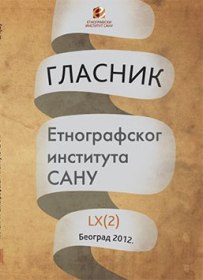Фаворизовање мушке деце међу муслиманским становништвом у Санџаку
Son Preference Among the Historical Sandžak Muslim Population
Author(s): Jelena Čvorović, Kosta NikolićSubject(s): Anthropology
Published by: Етнографски институт САНУ
Keywords: Muslims; Sandžak; son preferences; demographic polititcs
Summary/Abstract: This paper attempts to explain parental son preferences among historical Muslim population in the Sandžak region, southwestern Serbia. The paper draws upon data collected in the course of anthropological fieldwork studies in the region. The fieldwork was performed among Muslim and Christian families in Serbian rural area of Sandžak, measuring maternal fitness in relation to several variables. The data set comes from 120 women born between 1880–1924, representing so a historical demographic data based on individual and lineage records. These data were complemented with official records from Archive of Novi Pazar, whenever possible. In this Serbian rural area, land is still considered as an abundant resource, useful in establishing a family, livestock or agriculture. In the past, in spite of yearly fluctuations in production, lands and labor constituted a stable source of wealth from generation to generation. In this study, the data include the socio-economic status of each woman, assigned according to her husband’s family economic status: land-ownership vs. landless. This represents differences in resource availability in terms of nutrition, wealth and workload among these women. As the results show, the Muslim families, on average, left more surviving descendants through sons, in contrast with their Christian counterparts. The basic research question, then, is why? Furthermore, what were the impacts of particular behaviors on reproductive and lineage success, under particular social and ecological conditions? In this sample, regarding the Muslim families, the family structure was/is traditional and stratified, characterized by a large disparity in the status of males and females. Patrilineal inheritance, the concentration of wealth and power in males and the social restriction of women all characterize even today this patriarchal family arrangement. This supports the Trivers–Willard hypothesis, especially in terms of sex-biased parental investment after birth in the form of inheritance. In this population, wealth/land was heritable and has a positive effect on subsequent offspring reproduction; therefore, the lineages that concentrated inheritance in males outreproduced those that did not. To a great extent, religion is politics in this region of the world. Social and political tensions between different ethnic groups, drawn across religious lines, are central to the Sandžak cultures and it is also relevant in Serbia. In the Islamic Sandžak, even today, the position of women and women’s roles in reproduction occupies central positions in religious, popular, and political discourse. It may be assumed that the Muslim community response to these concerns, especially when they are a minority, is a stronger emphasis on aspects of family life conducive to childbearing. Larger family sizes, greater demand for children, and territorial expansions could be the tended outcomes of these group struggles.
Journal: Гласник Етнографског института САНУ
- Issue Year: LX/2012
- Issue No: 2
- Page Range: 55-72
- Page Count: 18
- Language: Serbian

